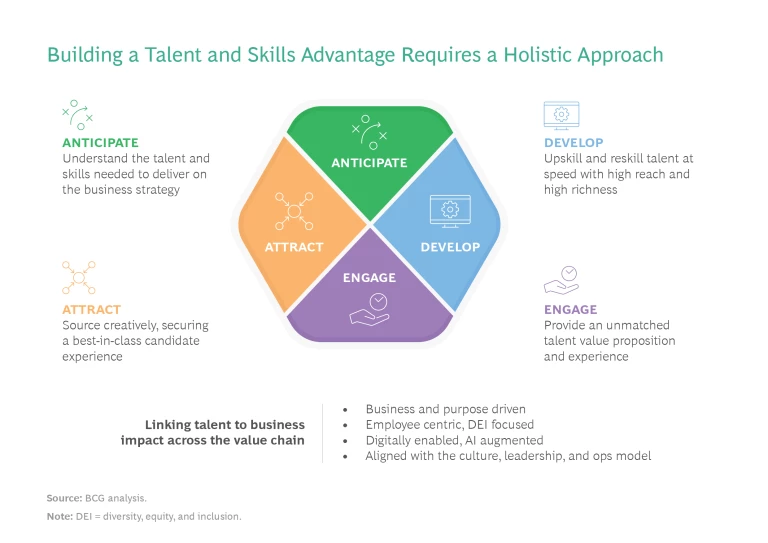The companies that capture the most value from AI follow the 10-20-70 rule: 10% of their AI effort goes to designing algorithms, 20% to building the underlying technologies, and 70% to supporting people and adapting business processes. To get the most from people and processes, companies need to address the following questions: (1) How do I attract, develop, and retain data and analytics talent to build sustainable AI capabilities? (2) How do I boost adoption of AI solutions at speed and at scale and drive real business transformation? (3) How do I rewire my organization to unlock the full benefits of AI at scale? This article, the start of a three-part series, focuses on the first question: how to attract, develop, and retain AI talent.
Artificial intelligence is having a moment. The release of ChatGPT, AI-enabled Bing, and Google Bard has electrified public debate on the radical potential of AI. To be an industry leader in five years, companies need a clear and compelling AI talent strategy today, but many organizations are hitting a brick wall. Although demand for AI talent is at an all-time high, supply is extremely limited. With so few skilled professionals available, companies must find ways to stand out from the competition.
Incumbents beware: the approach to attracting, developing, and retaining AI talent is not business as usual. Companies must offer a unique and compelling value proposition to attract—and hold onto—these highly prized recruits. To build a first-rate AI workforce that will stick around for the long haul, companies must anticipate what mix of AI skills (rather than jobs) is needed, understand what AI workers want and how to attract them, invest in reskilling and advancement opportunities, and keep AI talent fully engaged.
Common Mistakes to Avoid
AI and machine learning emerged as the most in-demand skills in 2022, and jobs for data scientists more than tripled over the past five years. Demand continues to outpace supply. Because AI employees have different job expectations than traditional workers do, recruiting and retention efforts need to be tailored to their unique needs.
Because AI employees have different job expectations than traditional workers do, recruiting and retention efforts need to be tailored to their unique needs.
Consider just a few common mistakes companies make when recruiting and hiring AI talent:
- Competing head-to-head with tech companies without highlighting non-tech-related differentiators that will entice AI hires
- Trying to recruit AI talent with the standard slow process led by generalist recruiters
- Paying premium prices for cutting-edge data scientists without considering the broader mix of skills needed
- Onboarding AI employees without creating a community and embedding them into the organization under AI-trained leaders
- Fiercely recruiting AI talent without providing advancement opportunities
- Overlooking reskilling opportunities within the organization
When companies make these kinds of mistakes, they not only struggle to hire the best and brightest but also face high levels of attrition. This is a serious problem in today’s job market where as many as 40% of employees working in digital fields are actively job hunting, and nearly 75% expect to leave their current role in the near future. The good news is that hiring AI talent doesn’t have to turn into a costly bidding war. Companies must understand what motivates these highly sought-after employees to take a job—and what it takes for them to stick around.
Four Strategies to Recruit and Retain AI Talent
To build an AI advantage, companies need to excel in four areas: anticipate talent needs , attract best-in-class candidates, develop talent quickly, and engage AI talent with an unmatched value proposition. (See the exhibit.)

Anticipate
Hiring the right talent to drive an AI transformation is not as simple as luring a strong team of data scientists and machine-learning specialists. An AI transformation requires talent with a mix of skills, including people who can build the data infrastructure (data architects, solution architects, data engineers, and software engineers), employees who manage data governance (data governance analysts and data stewards), and those who engage with the business (product owners and domain experts).
Start by developing a taxonomy of the skills you need and then figure out how best to acquire those skills. This approach is particularly important in a tight job market where top talent is scarce. When building an AI team, companies tend to reflexively hire people to fill predefined jobs. But businesses often struggle to fill those roles because AI talent is so expensive and hard to find. By focusing on the skills they need, companies can assemble effective AI teams more quickly.
For example, a global pharma company wanted to recruit a team of four data scientists to build up its AI capabilities, but the competition was fierce. By thinking creatively about the skills the company needed, executives realized they could hire just one high-caliber data scientist, supported by three data analysts, which are much easier to source. By finding the right mix of skills, rather than filling predefined roles, the firm quickly assembled a strong team and hit the ground running.
Companies also need to decide how to organize for AI. Most begin their AI journey in an ad hoc fashion. IT owns the data architecture, systems, and analytics, and data capabilities are sprinkled throughout the business, but no standardized roles or “communities of practice” are in place for sharing AI knowledge. This type of IT-focused organization makes it difficult to share solutions across the business and fails to give AI workers a clear path for internal advancement. As companies mature, the majority of AI talent will begin to work together in a centralized data and analytics hub, and roles will become standardized. Eventually, AI capabilities will be pushed back into the business while a small, centralized AI team remains in place to govern data management, develop capabilities, and codify best practices.
Last but not least, it is critical to anticipate the effect that incoming AI talent will have on the overall workforce. AI experts will become embedded in business processes, which means business experts will need to gain a working knowledge of data and analytics . As AI solutions are deployed, other employees’ roles will evolve over time, likely requiring them to acquire new skills or augment existing ones. In addition, processes will be redesigned and operating models will need to adjust.
It is critical to anticipate the effect that incoming AI talent will have on the overall workforce.
Attract
In the fiercely competitive AI environment, companies must think proactively about how to attract talent. Here are some key concepts to bear in mind.
Understand what AI workers want. Our research shows that potential AI hires have different job expectations than traditional job seekers do, and companies should tailor their employee value proposition to meet these expectations. Two things, in particular, matter to AI employees: (1) working on exciting products, topics, and technologies, and (2) knowing the company has a clear strategy for advancement. People involved in the fast-growing, constantly evolving environment of AI want to work on cutting-edge projects; 44% of AI workers ranked this as a top need (compared with just 27% of non-AI talent). When asked about deal breakers, AI talent ranked “interesting job content” much higher than non-AI talent did. AI job candidates also want answers to some important questions: Does the company think about data strategically? Where will I be at this company five years down the road? Will I have advancement opportunities? To keep AI talent engaged, companies need to articulate a detailed data strategy that highlights clear advancement opportunities.
Seek out untapped talent. It’s tempting to go after AI talent in the usual cities—San Francisco, Seattle, New York City, Bangalore, and London—but that guarantees you’ll be competing with all the hottest tech companies. This is particularly problematic for nontech incumbents striving to get an AI transformation off the ground. By looking at secondary talent pools in other cities and countries, organizations can gain access to extraordinary talent at more affordable rates.
Many of these hidden markets offer companies an edge because job candidates may be seeking something unique, such as a position located in their home state or more flexible work . In addition, our survey found that 68% of digital employees are willing to work remotely for a foreign employer. This opens up new options for hiring hard-to-find AI talent. Because visa limitations don’t apply to remote work, businesses can explore sources of talent that previously were not attractive or feasible. Start by evaluating your competitive advantage in various regions in terms of compensation packages, attrition rates, size, and unique value proposition. BCG analysis shows that companies using a targeted location strategy save 7% to 10% in labor costs.
Featured Insights: BCG’s most inspiring thought leadership on issues shaping the future of business and society
Create the right AI talent-sourcing strategy for your maturity. Customize your talent sourcing by making a clear-eyed assessment of your maturity. If you are new to AI, focus on recruiting an “anchor” hire; that is, a high-caliber AI expert who acts as a magnet to attract a broader network of AI specialists and establishes a strong starting strategy. As you scale up, elevate your approach to recruiting AI talent: leverage specialized AI recruiters, tailor hiring processes and compensation packages to meet AI talent needs, and ensure that leaders have complete transparency into recruiting outcomes. If you are fully mature and need to supplement existing data and analytics teams, build talent-sensing capabilities to understand where to find specialized AI talent and develop relationships with that talent in advance of your needs.
Tailor the recruiting process. The standard recruiting process does not work well when it comes to attracting AI talent. The process is too slow. By the time a hiring decision is made, the AI candidate may have taken another offer. In our survey, 66% of respondents said the number one way for an employer to stand out when recruiting AI talent is with a “smooth, timely recruitment process.”
Digital and data experts also want to be interviewed by people who understand their value. Managers involved in hiring should be staff who are integral to the AI mission, not only because they’re well equipped to assess candidates’ AI skills and judge their talent, but because it sends a signal that the company is serious about data and analytics. When managers who have little digital knowledge or expertise interview AI candidates, it dampens the potential hires’ enthusiasm for taking the job.
We recommend reviewing each recruiting step to expedite the process, particularly minimizing the time from final interview to offer, with the goal of following up in hours or days, not weeks. A global industrial company began daily standups with specialty recruiters and hiring managers to coordinate quickly on the hiring process. They prepared offer letters in parallel with final interviews, and a small, dedicated group of digital and data experts interviewed AI talent to improve decision making and calibration across candidates.
Develop
Approximately 80% of AI talent leave companies because they either want a more interesting position or don’t see opportunities for career advancement; however, BCG research shows that only 10% of new roles are filled by existing staff. A clear opportunity is at hand to support more internal mobility of talent. Reskilling internal employees offers a wealth of baked-in benefits. These workers are already committed to the organization, grounded in the business, and embedded in the company’s ways of working—all characteristics that take a great deal of time and effort to cultivate in new hires.
A clear opportunity is at hand to support more internal mobility of talent. Reskilling internal employees offers a wealth of baked-in benefits.
There’s another advantage to internal reskilling. The existing workforce can, in many cases, feel threatened by new AI hires, particularly if they are positioned as a separate group of young, highly compensated individuals poised to transform the organization. By offering reskilling opportunities, the business sends the message that anyone with the right skill sets, and a desire to learn, can play an integral role in the AI transformation. Not all jobs will lend themselves to reskilling; it’s unlikely that companies will train from within for the position of data scientist, for example. But many less specialized positions, such as product owners, data stewards, and domain experts, can be recruited internally. These opportunities for upward mobility, in turn, strengthen job satisfaction and loyalty to the organization. According to research from LinkedIn, employees stay 41% longer at companies that regularly hire from within.
For AI talent recruited externally, companies need to articulate a clear career path. When organizations try to quickly spin up an AI team, they don’t always take the time to develop a taxonomy that allows candidates to envision their progression within the organization. If young, ambitious AI analysts can be promoted to become senior AI analysts but are offered no other advancement opportunities, they will begin to look elsewhere just as they’re achieving peak productivity. In-demand recruits, such as data scientists and data analysts, also expect to be promoted more frequently. The tech culture has instilled the expectation that digital talent will be promoted every 12 to 18 months (as opposed to every two to three years).
Engage
For organizations that are not viewed first and foremost as tech companies or for those with a long product development cycle (such as aerospace and defense, where security constraints exist), it can be difficult to keep AI talent engaged. These organizations may have no trouble attracting AI talent, but employees’ enthusiasm can wane when they realize the development of next-generation hardware or products will take five or more years and they may not get to work in cutting-edge programming languages or platforms. In this case, it’s important to sharpen your storytelling so that you aren’t trying to compete with the best tech companies but instead can focus on your unique purpose and mission.
To become a purpose-driven organization, companies must answer two fundamental questions: What are our authentic and distinctive strengths? Why do we exist beyond what we make, do, or sell? Whether you’re an up-and-coming renewable-energy company, a 100-year-old cosmetics business, or a global tech giant, it’s essential to convey a strong narrative about what sets your company apart. Purpose-driven organizations energize people and keep them engaged.
The other key to keeping AI talent engaged is ensuring that they are seamlessly embedded within the organization as a whole. Onboarding should involve much more than a swift orientation. It should be a 6- to 12-month process that provides ample opportunities for new AI hires to work on meaningful, “quick hit” projects that have an immediate impact on the business. To make sure that top talent isn’t bogged down with data management challenges (building the data platform, accessing data, cleaning data, and so forth), companies should adopt a two-speed approach. Allow a team of engineers to build digital capabilities while AI specialists deliver high-impact AI initiatives that offer clear, compelling results for the business. The executive team should also include data and analytics initiatives in their annual goals so that AI teams aren’t fighting for mindshare, business sponsorship, and budget allocations.
Case Study
By implementing many of these techniques simultaneously, a leading biopharma firm quickly ramped up its AI team. Here’s what the company did:
- Reshaped job architecture and skills taxonomy to focus on hiring for skills that were most relevant in the market, defining roles for machine-learning engineers for the first time
- Redefined its employee value proposition and created stronger communities of practice for AI talent, connecting AI practitioners across the R&D, commercial, and IT organizations
- Reframed the company’s talent acquisition strategy to better communicate its value proposition, created a dedicated team of specialized AI recruiters, and changed hiring processes
In just six months, the company boosted the size of its AI drug discovery team by approximately 10%, increased its commercial analytics organization by about 25%, and dramatically reduced its attrition rate for data and analytics talent.
Talent scarcity is one of the main concerns for executives worldwide. To date, few companies have successfully scaled AI , but this will change as organizations are ramping up very quickly. By embracing a smart approach to recruiting, retaining, and engaging AI talent, companies will gain a long-term competitive advantage in a field that is fundamentally redefining the future of business.
The authors thank the following experts for their contributions to this article: Romain Gailhac, Orsolya Kovács-Ondrejkovic, and Anne-Françoise Ruaud.













